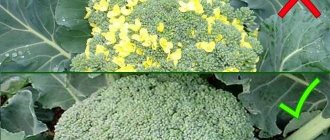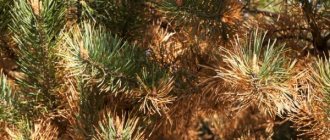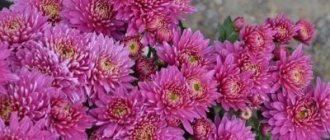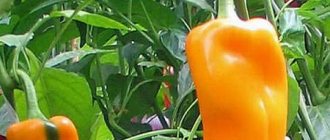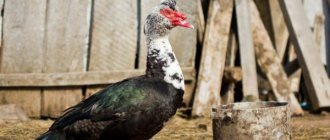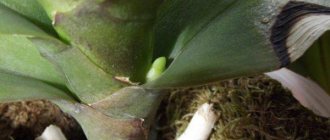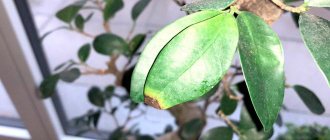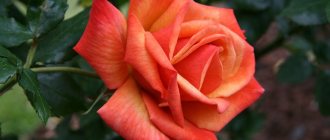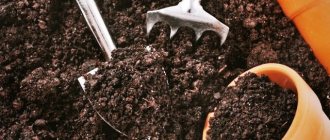Bushes and trees
0
626
Article rating
Kira Stoletova
Thuja belongs to the evergreen coniferous species and is used by gardeners in landscape design to decorate their garden plots. For good growth, it is recommended to feed the thuja 3 times - in spring, summer and autumn. This will ensure its active development and prepare it for the coming winter.
How to choose fertilizer for the rapid growth of thuja
Which food to choose
After planting in open ground, thuja is not fed for several years, because Ash, organic matter, etc., introduced into the planting pit at the initial stage, act as a source of obtaining all the necessary useful elements.
They usually begin to fertilize trees after 2-3 years.
The main components that conifers require:
- nitrogen - in small doses it serves as a growth stimulator for young seedlings, but its excess leads to the loss of decorativeness of the crop and makes the crown loose;
- phosphorus and potassium ensure full development and are the key to the bright color of the needles and the density of the shoots, stimulate the growth of the root system and increase the plant’s resistance to the adverse effects of environmental factors.
You can determine which element the thuja is missing by its appearance:
- iron - the needles become light yellow or whitish;
- phosphorus - in young shoots the needles turn red-violet;
- nitrogen - the appearance of new shoots stops, the needles become discolored (chlorosis occurs);
- potassium and magnesium - the upper part of the plant turns yellow.
Spring feeding
After planting, the next fertilizers are applied every other year. In early spring, mineral preparations are used. Depending on the climate, they should be applied from the beginning to the end of March.
Superphosphate
Starting from 1 year old, thujas are given superphosphate powder. The name of the drug is justified, since it contains more than 20% phosphorus. The composition also contains calcium, sulfur and magnesium. The powder is scattered under the trees, embedded 4-5 cm deep into the soil.
Superphosphate has undeniable advantages - it is suitable for any soil, is quickly absorbed, and prevents some diseases. The powder helps the root system to form. To prevent it from losing its beneficial properties, it is mixed with other drugs according to the instructions. In a solution with ammonium nitrate, lime, urea, gypsum, it is neutralized.
If the thuja grows in acidic soil, add lime or ash a month before adding superphosphate. They deoxidize the soil, and the drug is more easily absorbed. Experienced gardeners add potassium salt, boron and zinc to superphosphate. For 2 g of the drug, 1 g of salt, 10 mg of boric acid, 20 mg of zinc sulfate are required.
If there is a lack of phosphorus, double superphosphate is used , containing up to 46% of the trace element. In addition to phosphorus, it contains aluminum and iron.
Ammonium nitrate
The drug contains more than 30% nitrogen, 14% sulfur. The latter improves the absorption of nitrogen by the root system. In the spring, the area is fertilized with a solution of ammonium nitrate. For it, take 30 g of powder and 10 liters of water. This amount is enough for 1-2 plants. If the thuja grows in acidic soil, calcium carbonate is added to the saltpeter.
Bone flour
Bone meal is used for many plants, as it contains many microelements. It is made from animal and fish bones, which are ground to a powder. The substance is beneficial for thuja and soil. Phosphorus, which is slowly released, saturates the plants for several years.
The powder contains the following components:
- nitrogen;
- phosphorus;
- copper;
- cobalt;
- iron;
- manganese;
- iodine.
Due to the high percentage of nitrogen and phosphorus, bone meal is called phosphonitrogen.
The drug can be purchased in various variations - standard (up to 15% phosphorus), steamed (up to 25%), low-fat (up to 35%). Flour is used dry, scattered over the area or under digging. A handful of powder (100-150 g) is poured under each tree, as it is quite concentrated. Bone meal can be used when planting - 100 g in each hole. The reserves after such fertilizer are enough for development throughout the season.
Dry application is effective only on loose soil.
Bone meal solution is suitable for heavy soil with poor air permeability. It is prepared from 1 kg of dry matter and 20 liters of water. Before this, the liquid is heated, but not boiled. The product is infused for 10 days, after which it is ready for use. Bone meal is popular among gardeners because it is inexpensive, contains all the necessary minerals, and does not harm the environment.
Root stimulator
Thuja responds well to growth stimulants. They are needed when the roots are frozen or the branches are sunburned. The drugs allow the plant to recover faster.
Kornevin
The drug belongs to the group of phytohormones - agents that stimulate root formation and increase the protective forces of plants. Kornevin contains indolylbutyric acid. Once in the soil, it turns into a hormone that stimulates growth. When it comes into contact with the trunk, it irritates the tissue, causing the formation of callus. Callus is an area with new cells that close plant wounds.
Kornevin is an addition to standard fertilizers. It does not replace organic and mineral products.
Before use, put on a mask and gloves, and prepare a separate container for the solution. 5 g of the drug is diluted in 5 liters of water. The seedlings are immediately watered with the liquid: the first time when planting, the second time after 14 days. One plant requires 2-2.5 liters of solution.
The product is also applied in dry form - the roots of the seedlings are dusted with powder. Since Kornevin is concentrated, it is mixed with an equal amount of crushed activated carbon. To protect against fungi, a fungicide is added to the powder in a ratio of 10:1. The drug protects thuja from drought, overwatering, and temperature changes.
Agricola
Agricola is a mineral preparation for root and foliar feeding. It contains nitrogen, potassium, phosphorus, zinc, molybdenum, copper, manganese. Especially for conifers, humic acids are added to it. It can be purchased in the form of granules and a concentrated solution. The wet method is more often used: 25 ml is dissolved in 10 liters of water. The product is poured while simultaneously mixing the liquid in the container. Depending on the height of the thuja, 3-5 liters are needed per tree. The next portion is added after 2 weeks.
When spraying leaves, microelements are absorbed faster.
The advantages of Agricola include the absence of heavy metals, chlorine, high efficiency, and economy. The product strengthens the leaves, promotes good growth, and increases resistance to adverse influences. Iron, magnesium and sulfur make the color of the branches rich green. It is indispensable on dry salty soils. Agricola is used throughout the growing season - from spring to autumn.
All young plants require nitrogen fertilizers. The seedlings have an underdeveloped root system, so they do not extract the necessary microelements from the soil. When they grow, fertilizing is carried out to maintain the composition of the soil.
Deadlines for depositing
Conifers are fed several times a season.
- Spring. Apply immediately when signs of nutritional deficiency become noticeable - the color of the needles and the general condition of the crown change. Applying fertilizing in early spring acts as a means of quickly awakening the thuja, this helps it recover from the cold and activates vegetative processes. Suitable period is March.
- Summer. Fertilizers are applied if the tree was not fertilized immediately after winter, but more often they are limited to foliar spraying without nitrogen. The best root fertilizers for irrigation will be solutions prepared on the basis of vermicompost and complex products with protective properties against fungal diseases and pests.
- Autumn. Top dressing is suitable for thujas grown in the southern regions. The main attention is paid to the root application of fertilizers on greenery. Suitable period is September-early October.
How to determine what thujas are missing?
With a lack of nutrients, the appearance of the plant changes:
- nitrogen - growth slows down, new shoots stop forming, symptoms of chlorosis appear;
- phosphorus - young needles acquire a purple tint;
- potassium - the upper part of the crown turns yellow, tissues die;
- iron – the color of the aerial part changes to light yellow or white;
- magnesium - the top dries out, becomes yellow and brittle.
Excess nutrition also negatively affects the appearance of the plant. Overfeeding with nitrogen is especially dangerous. When applied in the fall, the branches begin to grow actively, but do not have time to become woody before winter, which is why they freeze out with the onset of cold weather.
Types of fertilizers
You can feed thuja with different fertilizers: organic, mineral and complex compounds.
Organic
Such fertilizers improve the structure of soil layers and activate the vital activity of beneficial bacteria found in them.
Organic matter (humus, compost, rotted manure) for feeding thuja is used mainly in dry form, mixed into the soil at a shallow depth in the root area.
Do not feed conifers with fresh, unrotted manure and chicken droppings - they have a high concentration and burn the roots.
Finished preparations produced by the agricultural industry based on organic components.
- Biud - it contains waste products of cattle and minerals in an easily digestible form;
- Humvit-eco is made on the basis of vermicompost, which stimulates vegetative processes.
Minerals
The health of the tree depends on the correct application of fertilizers.
For coniferous species in the spring, mineral complexes are needed that contain high doses of potassium, magnesium and phosphorus.
Ready-made preparations quickly and effectively replenish nutritional deficiencies, eliminating starvation.
Unlike deciduous plants, thujas do not require a lot of nitrogen, which contributes to the growth of green mass, because this component does not have a significant effect on growth.
Feeding with minerals is allowed only in the dosages specified in the instructions.
Urea, ammonium nitrate and nitroammofosk help to compensate for the lack of nitrogen in the soil immediately after planting. They are applied in dissolved or granular form.
Dry fertilizing allows you to simultaneously combine the replenishment of missing elements and loosening the soil.
The application of nitrogen is stopped at the onset of summer, so that new shoots do not grow, which weaken the conifer, do not have time to become lignified by winter and, as a result, freeze out.
Fertilizer complexes
You can feed thuja with complex fertilizers designed for coniferous trees.
They contain a set of useful elements necessary for full development. Their concentration and cumulative effect allows you to save on consumption by applying them every 3-5 years.
The most popular among gardeners: Khvoinka, Zdraven, Aquarin, Fertika, Green Needle.
Upon landing
When planting in spring, preference is given to organic means. Before planting seedlings, the following substances are used:
- compost;
- humus;
- ash.
Substances are added to the hole, providing young plants with strength to grow. One plant requires 2 buckets of fertilizer and 3 kg of wood ash. When filling the hole, compost is added to the soil.
A single feeding when planting seedlings is enough for 1 year. Excess microelements harms the plant.
Compost
Compost is a product obtained from the decomposition of plant waste. It preserves beneficial substances and bacteria. Microelements are in accessible form and are easily absorbed. Benefits of compost:
- balanced mineral composition;
- 1 million bacteria per 1 g of substance;
- improvement of soil structure;
- providing plants with heat;
- facilitating the penetration of water to the roots.
The product is applied to the tree trunk annually. If there is no such amount of compost, the trees are fed one by one. The compost is worked into the soil with a rake, being careful not to touch the roots. If it is buried deeper than 10 cm, beneficial aerobic microorganisms die. The result should be a layer of about 5 cm. The second option is digging in with a garden drill. Make holes in the soil according to the size of the crown, adding 1 shovelful of compost into each hole.
Сompositum is translated from Latin as folded together.
Humus
To plant thuja, rotted manure is prepared, containing a lot of nitrogen, phosphorus, and potassium. It also contains many beneficial microorganisms that facilitate the access of minerals to the roots and improve the properties of the soil. Manure is diluted with water in a ratio of 1:3 and left for several days. When planting seedlings, the solution is diluted again with 3 buckets of water.
Only rotted manure , since fresh manure has a high concentration of substances that can cause burns.
Wood ash
Ash contains a huge range of microelements, but a small amount of nitrogen. Therefore, it is applied together with other organic and mineral fertilizers. Ash contains a lot of potassium, phosphorus, calcium, magnesium and sodium. Its effect on thuja is similar to superphosphate.
The product is not suitable for alkaline .
The following types of ash are used to enrich the soil:
- grape;
- coniferous
- deciduous;
- potato;
- wheat;
- rye;
- sunflower.
Wood ash normalizes soil acidity, protects against root rot and pests, and provides material for the development of thuja.
Folk recipes
Fertilizer for thuja can be prepared using folk remedies.
Herbs
Feeding solutions are often made from herbs that contain nitrogen in their chemical composition: clover, nettle, spurge, wheatgrass, woodlice and dandelion.
To prepare working fluids, vegetation is harvested before the seeds appear.
The chopped grass is placed in a plastic barrel (filled 2/3 full), and water is added. Add ammonium nitrate or urea to the mixture in the amount of 5 tbsp. for every 50 l.
Cover the container with a lid or polyethylene, make holes for gases to escape and place in the sun for 1-1.5 weeks, stirring occasionally.
You can increase efficiency by adding wood ash and bone meal.
The herbal solution, ready for use, becomes dark brown in color. The working fluid for fertilizing is diluted with water in a ratio of 1:10.
Yeast
They contain in their chemical composition amino acids and microelements necessary for the ephedra to stimulate growth and improve immunity.
Recipe: 35 g of diluted dry yeast, 2 tbsp. granulated sugar is dissolved in 0.7 liters of water and placed in a warm place.
The liquid is ready for use after fermentation is complete. For irrigation, the concentrate is diluted in water at the rate of 1 tbsp. for every 10 l.
Fertilizer feeding and mulching
Thujas respond well to mulching - covering the soil surface with special materials. Thanks to the procedure:
- roots do not suffer from temperature fluctuations;
- moisture evaporation is reduced, which allows reducing the frequency of watering;
- there is no need for weeding, since weeds cannot break through the mulch;
- Fertility increases when organic materials are used.
The decorative coating beautifies the plantings and keeps them clean even in rainy weather.
Thuja is mulched:
- chopped branches;
- peat;
- sawdust;
- straw.
The coating is updated as necessary.
Basic rules of procedure
The soil must be moistened before fertilizing.
- The interval between adding compositions with different elements should be 2 or more weeks.
- In the fall, stop using all mineral and organic complexes, because... Late stimulation of vegetation processes negatively affects future wintering, with the exception of conifers grown in southern areas.
- A day before the planned date of fertilizing, the tree trunk circle is watered with water to moisten it; fertilizers are not applied to dry soil.
- Mineral complexes alternate and do not use together those containing the same components, because there will be an oversupply.
You can feed in one of the following ways - by applying at the root or by spraying along the crown.
Root feeding
Root feeding consists of laying granular preparations or watering with liquid solutions.
Fertilizers are applied to the tree trunk circle, not reaching closer than 15 cm to the trunk, after which it is mulched with peat, pine needles or tree bark.
Mulch additionally serves as an obstacle to the evaporation of moisture, creates breathability of the upper layers and protects against the appearance of weeds.
Deadline for root application:
- in the spring, spread evenly over the surface of the moistened soil and dig up, the consumption standard is 30-40 g per tree;
- throughout the entire growing season, from May to August, 2 times, standard - 60 g per 1 m².
Foliar feeding
Foliar spraying along the crown helps to absorb nutrients faster and more efficiently through the needles.
Compared to root fertilizers, the percentage of fertilizer digestibility is 2-4 times higher and is about 80%.
Application time – from May to August, frequency – once every 14 days. The number of irrigations per season is 3-4 times.
Spray the crown using sprayers and atomizers with preparations based on complex metal compounds - chelates. These include Kvatum, Brexil, Aninomax, Kafom.
Epin and Zircon act as growth stimulants that reduce stress conditions in plants under unfavorable growing conditions.
How to feed
To get the most benefit from any fertilizer, follow these simple recommendations:
- Take a break between fertilizing with preparations with different components (15 or more days).
- Try to alternate batteries of chemical origin. In addition, it is extremely undesirable to use complexes containing the same components together.
- A day before the planned feeding, thoroughly moisten the tree trunk area.
- You can fertilize thuja using two methods - under the rhizome or using the foliar technique (spraying along the crown).
- A mineral product in the form of granules can be simply spread over the surface of the ground under the tree.
- Dilute liquid mixtures (organics or minerals) following the included instructions. This way you will prevent burns to horses and damage to branches with highly concentrated liquid.
The health of the thuja and its growth largely depend on the efforts made by the gardener in such an important agricultural technique as fertilizing. Timely applied fertilizer, a competent combination of elements and calculation of their volume will allow you to admire the luxurious green needles on your site for a long time.
Typical gardener mistakes
In the process of fertilizing, newbie gardeners make typical mistakes:
- do not adhere to the schedule and do not observe regularity, which leads to disruption of the growth rate;
- they confuse the tree’s need for certain nutrients at different stages of development, for example, in the first stage of the growing season an increased amount of nitrogen is required, and in the second - an increased supply of phosphorus and potassium;
- exceed the dosage specified in the instructions, as a result of which the root system is burned, excess fertilizer leads to a slowdown in the growth of conifers and causes unfavorable changes in appearance;
- they do not prepare the soil before using fertilizing complexes and water them with working solutions and bury granular mixtures in dry soil that has not been moistened in advance, which causes injury to plant roots.
How to choose spring fertilizer
In order for the thuja to grow and delight its owners, it is important to learn how to properly care for it. In the spring, the plant will need to be fertilized.
In order not to harm the plant, you need to take the choice of fertilizer seriously. You can find ready-to-use fertilizer on the market.
One of the most popular products is Zircon. A large number of people have tried it. The solution is able to strengthen the roots of the plant, as well as improve the absorption of all important substances. In addition, this substance effectively helps thujas cope with diseases. And that’s all, because it perfectly resists viruses.
In addition, “Bioud” has also proven itself on the positive side. It is used three times during the spring. It provides the tree with the necessary microelements.
Fertilizer for thuja in spring can also be natural. It will have a beneficial effect on the entire tree. For example, this is the well-known compost.
Also, you should give preference to mineral or water-soluble products.
Signs of lack of nutrition in thuja
Thuja is grown in gardens and homesteads. It is often used in landscape design, planted in flower beds and along the fence. It grows quickly and develops well, but if the trees and bushes are not fed on time, signs of a lack of minerals will appear.
When the crown begins to turn yellow en masse, the thuja picks up magnesium and potassium
- If the green color of the thuja changes to red hues, it means there is not enough phosphorus in the soil. A simple fertilizing with phosphorus fertilizer will be enough to save the thuja.
- The light yellow color of the branches indicates a lack of iron.
- When the crown begins to turn yellow en masse, the crop lacks magnesium and potassium. In this case, as in the previous one, it is necessary to urgently apply fertilizers against yellowing, otherwise the plant will continue to change color and die over time.
- If from spring to summer the thuja practically does not produce young branches, this is a sign of nitrogen deficiency. But it is not recommended to apply it in late summer or autumn. Only in the spring will this element benefit the culture. In summer it is added in small quantities.
Important!
If you apply nitrogen fertilizers in summer or autumn, the thuja will produce a lot of young, green branches that will not ripen and freeze until winter. So you should carefully monitor the amount and timing of nitrogen fertilizer application.
How to feed thuja in the summer?
The optimal root feeding in summer is not considered to be solutions prepared from complex fertilizers, but the separate introduction of vermicompost or anti-fungal components.
How to feed thuja in the summer:
- If the needles do not turn yellow, in general the crop grows well, then it does not need separate feeding in the summer. Things are different if the plant feels unwell, the color of the crown has changed, or sudden wilting is observed.
- In this case, feeding may be necessary. Determine the cause of the plant’s deterioration and eliminate it. In each individual case, it is necessary to introduce a specific fertilizer, depending on the disease and the crop.
- In the summer, dolomite flour, compost, and special fertilizers designed for coniferous plants are usually applied.
Watering
Mycorrhizal preparations for thujas
Mycorrhizal vaccines can be used in addition to fertilizers. The preparations contain mycorrhizal fungi, which have the following effects on plants:
- increase the absorption capacity of the root system;
- improve water supply;
- reduce sensitivity to environmental stress;
- increase resistance to fusarium, late blight and other diseases;
- stimulate root growth;
- increase the availability of nutrients.
With proper feeding of the thuja and proper care, the plant will delight you with its beautiful appearance and green needles.
Pests and diseases of thuja
Thuja, as an ornamental plant, is quite often subject to insect attacks and some diseases. Here are the most common of them:
- Fungal infection. It is easily distinguishable by its brown shoots and yellow needles. Cut off affected shoots as soon as you notice them and burn them. And then, spray the entire thuja with foundationazole.
- Thuja aphid. This infection can destroy the entire tree. You can destroy aphids and cure a tree using karbofos.
- False shield. This disease is also easily recognized by the presence of growths on the needles, similar to cones. To eliminate the infection, use the drugs Rogor and Karbofos.
- Tree disease due to drying out of the soil or due to excessive watering. Both will contribute to the rapid rotting of the soil, after which the tree will inevitably die.
Conditions for growing thuja
Thuja should grow in well-drained, fertile and moderately moist soil. In dry soil it may die. You can take ready-made soil for coniferous trees, available in stores, or peat substrate mixed with rotted compost or pine bark. Around trees, gardeners recommend covering the soil with forest soil or soil with a mulch of needles and pine cones. In what soil should thuja be planted, given the type of plant? It should be remembered that the western thuja (Arborvitae) grows best in calcareous soil, while the oriental thuja, or eastern cedar, loves acidic soil.
There should be no weeds or earthen clods in the place chosen for planting. If thujas are planted as a hedge, you need to prepare a plot of land at least 80 cm wide. The entire area is covered with black film until planting to prevent weeds from appearing.
When planting, thujas take a lot of fertile soil. Its quantity should exceed three times the size of the hole. You need to pour thirty centimeters of soil at the bottom and immediately spill it with water. Place a seedling on it, cover it with soil, press the soil down and water it again.
After planting the seedling, you need to apply mycorrhizal grafting material. To slow down the development of weeds and reduce water evaporation, pine bark is laid out in a thick layer around the thuja.
Features of caring for an evergreen plant
We talked about the fact that thuja requires minimal care. Even if you leave the tree to grow without your help, it will still grow and be green, but outwardly it will not look as good as it could, and its lifespan will most likely be reduced to 50-70 years.
A healthy flowering plant will delight you for many years with careful care:
- Systematic watering. Thuja occidentalis Smaragd loves moisture very much and does not tolerate soil drying out. In the summer, thuja must be irrigated with water at least once a week, and in all other seasons, 1-2 times a month will be sufficient. The tree will be grateful to you if you periodically spray it with water, thereby eliminating dust deposits and various small insects.
- Take care of the soil and soil around the plant. Remove weeds and destroy insect nests. Firstly, this will support the aesthetics of your planting, and secondly, this way you saturate the earth with oxygen, which means you contribute to the faster development of the plant;
- Do not forget to periodically loosen the soil. This is very important for providing the root system with oxygen. Please note: you need to loosen shallowly and very carefully, since you remember that you planted the thuja shallowly.
- It is important to mulch the soil once a year by adding peat and tree bark.
- Feed the plant with fertilizers 2 times a season.
- Trim your tree periodically. Careful sanitary pruning will help you get rid of dry shoots. Use only sharp pruning shears for gentle pruning.
- Cover your trees standing in the sun from the heat with a thin blanket.
Thuja has changed color, what should I do?
Don’t panic if you notice light green thuja shoots in early spring. These are young shoots that differ in color. The plant is not sick with anything, this is a physiological process.
Thuja has changed color, what to do:
- You should be wary if the color of the needles changes. If the shade turns almost white, this indicates an iron deficiency. For treatment purposes, iron chelate is used. Prepare a one percent solution and spray the tree crown. Iron cannot be added to the roots.
- A fine spray is used for spraying. To prevent iron deficiency, spraying is carried out twice a season - in March and early summer. However, for this purpose a 0.5% solution of iron chelate is used.
- If purple tips form on the branches, this indicates a phosphorus deficiency. A fertilizer consisting of superphosphate is applied. Sprinkle 50 g of the product near the tree trunk. After adding fertilizer, amend the soil and water the plant well. There is no need to dissolve superphosphate in water and water the roots.
Landing
Use of one-component mixtures
Fertilizing of thuja in autumn, spring and summer is carried out with one-component fertilizers, if this is due to the chemical composition of the soil. For example: on sandstones there will always be a lack of nitrogen, so it is applied more times, including by foliar method. Poor soils deficient in phosphorus do not allow plants to grow their root systems. Because of this, the above-ground part of the tree suffers:
- the needles change color from green to purple or red;
- there is less greenery, so the branches become bare;
- a large number of cones ripen - this is a signal that the thujas do not have enough nutrition and they may die.
Perhaps you should apply a long-lasting fertilizer for thujas in the fall - phosphate rock, horn shavings or bone meal. All of them contain calcium, without which normal growth of needles is impossible.
What to feed thuja in the fall is chosen based on the characteristics of the soil or on the advice of an agronomist at the farm where the seedlings were purchased. If you write down tips in detail on a piece of paper, you can avoid many mistakes. It must be borne in mind that farms use various fertilizers in large quantities to preserve planting material.
The gardener’s job is to accustom the tree to its own soil on the site and create optimal conditions for the growth of thuja. Of course, propagating the tree yourself would be a plus, but it takes too much time. More on this later in the article.
